So what caused brothers to take opposite sides and fight against each other? Probably the easiest answer is the slavery issue but that was really only a by-product of the root issues. Prior to 1861 the United States of America were known as separate states that each created their own laws and regulations. Concerns over taxation, commerce and eventually slavery led to heated debates over whether a central government or individual states should decide these issues. So, at the core of the Civil War was a decision of states' rights vs. a central government.
Eventually eleven states seceded from the Union and five additional border states had strong sympathies with the South. It was a politically, economically and socially unstable time for our country... perhaps not so unlike today. Abraham Lincoln was the President of the United States while Jefferson Davis was the President of the Confederacy. Both were strong, capable men, each with a different vision for the future of his country.
We started our tour at the Visitor's Center.
The Battle of Gettysburg, the most famous battle of the Civil War, took place July 1-3, 1863 in and around the small town of Gettysburg, Pennsylvania. Ten roads from ten nearby towns in Maryland and Pennsylvania converge in Gettysburg making it a transportation and communication hub and desirable property for both the Union and Confederate Armies. What began as a small skirmish when the Confederate Army (who was searching for food and shoes) saw the Union Army camped out in Gettysburg ended with 51,000 dead, wounded and missing.
The Battle of Gettysburg is really a series of several battles. One of my favorites occurred on July 1st on the west side of town at Seminary Ridge where a small faction of the Union Army was trying to keep the Confederate Army out of town. General John Reynolds of the Union Army brought reinforcements for General Buford's forces. Reynolds was a highly respected general; some thought he was the best that the Union had. He was mortally wounded when a musket ball struck him in the head as he was on his horse giving orders. Had he lived, some historians think he might have been the commander of the Union Army instead of Ulysses S. Grant and perhaps would have become president instead of Grant. Interesting to ponder the "what if"...
The Memorial in the photo on the left marks where General Reynolds was killed during battle. The photo on the left is his Memorial.
Every war has its heroes and the Civil War was certainly no different. Northerners would claim Reynolds, Grant and Lincoln as heroes while Southerners would boast about Lee, Jackson and Davis. But my favorite Civil War hero is a female named Sallie who was attached to the 11th Pennsylvania Infantry, an intensely loyal unit recruited as a three month regiment in April, 1861. They earned the nickname "The Bloody Eleventh" in the Battle of Falling Waters in July that same year. Reorganized as a three year regiment in August, 1861, they fought in many battles throughout the Civil War including the Battle of Gettysburg. July 1st was a day of intense fighting and when night fell and the fighting stopped, the fields were littered with dead, dying and wounded soldiers. Sallie, tired and hungry, crept out onto the battlefield and comforted the dying and wounded soldiers, keeping watch over them until she was found weak and near death herself on July 4th. After regaining her health, she continued to fight with her unit in every battle until she was mortally wounded at Hatcher's Run in February, 1865. The men gave her a proper burial. I should mention Sallie was the unit's beloved mascot, a brindle bull terrier who traveled everywhere with the unit. It has been said she hated three things: Rebels, Democrats and Women.
Sallie's likeness is forever memorialized at the base of the 11th Pennsylvania Infantry memorial at Oak Ridge in the Gettysburg National Military Park.
As I contemplate what war would look like in the mid-1800’s I am struck by the realization that it would be very personal. Unlike modern warfare where soldiers seldom see the enemy, the Union and Confederate soldiers often not only saw the “whites of their eyes”, they sometimes realized they were fighting their own family members.
The cannons could shoot as far as one to three miles depending on the type but had to use scouts to know where the enemy was... still an up close and personal war. In the photo on the right, the stone wall in the foreground was used to conceal Union soldiers. Confederate soldiers were across the field in the trees behind the picket fence in the middle of the photo. They charged across the field, dismantled the picket fence during their charge, crossed the road and headed up the hill to the stone wall. Union soldiers held their ground and massacred the Confederate Army. This was (General) "Pickett's Charge" - the turning point for the Battle of Gettysburg which in turn was the turning point for the Union Army's eventual victory over the Confederacy.
Like every war the United States engaged in up to this time, this war was fought in the cities and farms of America with ordinary citizens as witnesses- something that has not happened since that time. But it reminds me that the citizens of far off war-torn countries experience that same horror.
Fighting took place on the farms outside of town as well as in town. Wounded were buried where they fell... in farm fields and gardens. Houses, barns and public buildings became hospitals for the wounded.
We visited Gettyburg in the fall- the day was crisp and beautiful. But what would it have been like in the middle of summer? I tried to picture the battlefields very green, with lots of undergrowth. The average temperature in July is 86 degrees (F) with stifling humidity. Bugs would have been everywhere. In other words, it would have been miserable.
Our visit to Gettysburg was beautiful- fall colors, not cannon balls, exploded all around us and the air was cool and crisp, not laden with heat and humidity.
Perhaps the most visible, obvious thing in Gettysburg National Military Park is the number of monuments and memorials. There are almost 1400 monuments and memorials in the park making it one of the largest collections of outdoor sculpture in the world. The first monument was a memorial urn placed in Soldiers' National Cemetery in 1867- just four years after the battle- by the state of Minnesota to honor the First Minnesota Infantry which suffered huge losses during the battle. Many of the monuments and memorials were placed during the lifetimes of the soldiers who fought there and tell their story as well as honor them.
The Pennsylvania Memorial, completed in 1910, is the largest in the park and lists the name of every Pennsylvanian who fought in the battle- 34,530 men- on the bronze plates at the base of the memorial. Eight bronze statues of military figures are in niches on either side of the four archways.
Gettysburg National Cemetery (originally "Soldiers' National Cemetery") was our final stop. Leading Gettysburg citizens, distressed at the poor condition of soldiers' graves all over town, begged the governor (Andrew Curtin) for state support to purchase a portion of the battlefield to be set aside as a cemetery for the defenders of the Union cause. Gettysburg lawyer David Wills was appointed the state agent to coordinate the establishment of the "Soldiers' National Cemetery." Removal of the Union dead to the cemetery began in the fall of 1863 but was not completed until long after the dedication in November, 1863.
Today, soldiers from many wars have their final resting place at Gettysburg National Cemetery. It was an honor to walk along the quiet paths of this cemetery reflecting on the sacrifices every soldier in every war/conflict has made.
Soldiers' National Cemetery was dedicated on November 19, 1863. Many prominent people spoke at the dedication- statesman and orator Edward Everett spoke for two hours, songs and hymns were sung and solemn prayers to honor the men who died at Gettysburg were prayed. But it was President Abraham Lincoln's Gettysburg Address, a speech lasting only two minutes, that captured the hearts of the 15,000 in attendance as well as future generations.
It is here that President Lincoln gave his famous Gettysburg Address. I think it's interesting that he felt no one would remember his words after the dedication- yet they became one of the most famous and well-known speeches of all time.
"...we here highly resolve that these dead shall not have died in vain; that this nation shall have a new birth of freedom; and that this government of the people, by the people, for the people shall not perish from the earth." Abraham Lincoln
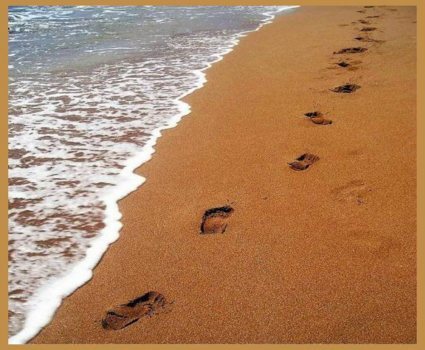
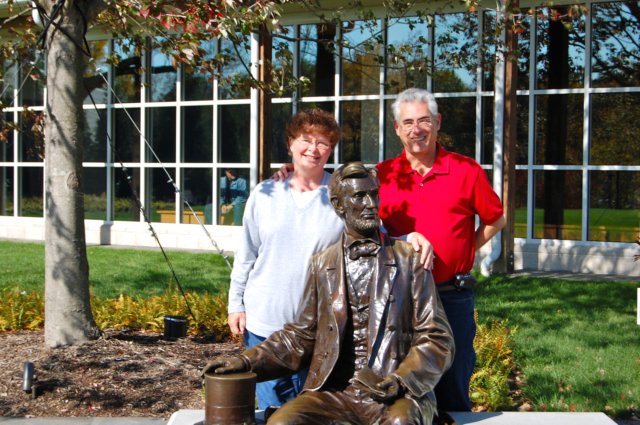
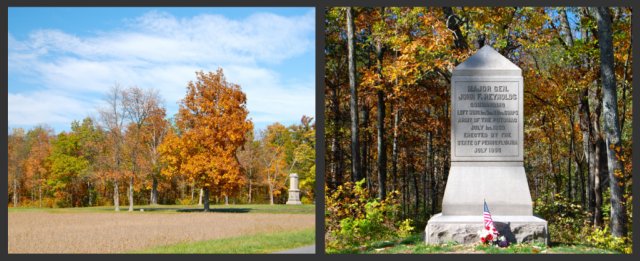

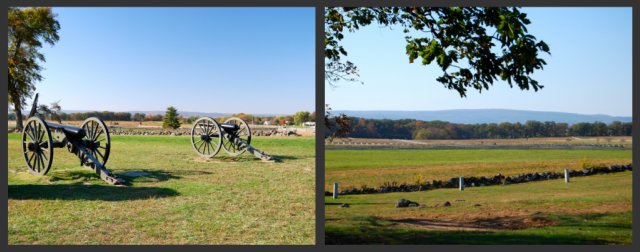

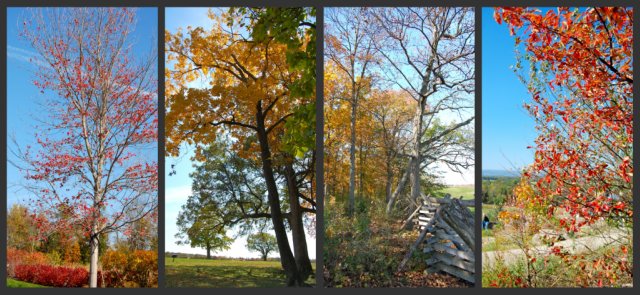
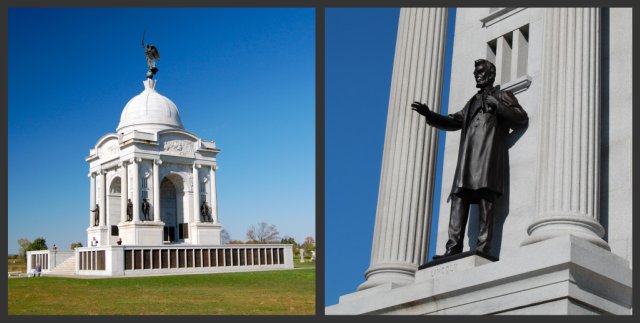
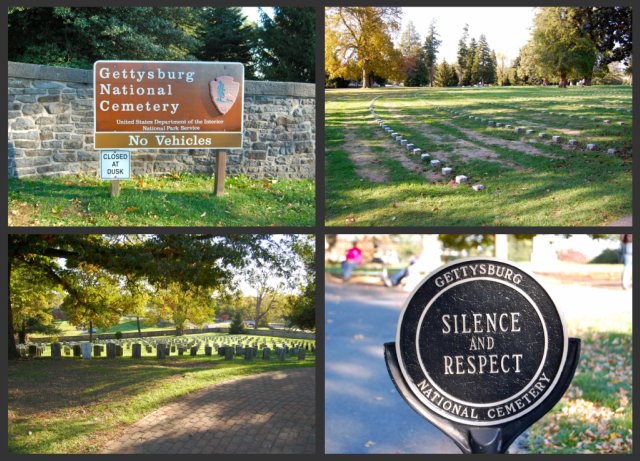
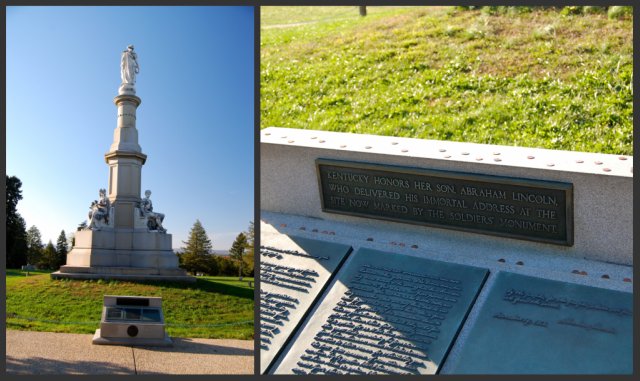
No comments:
Post a Comment